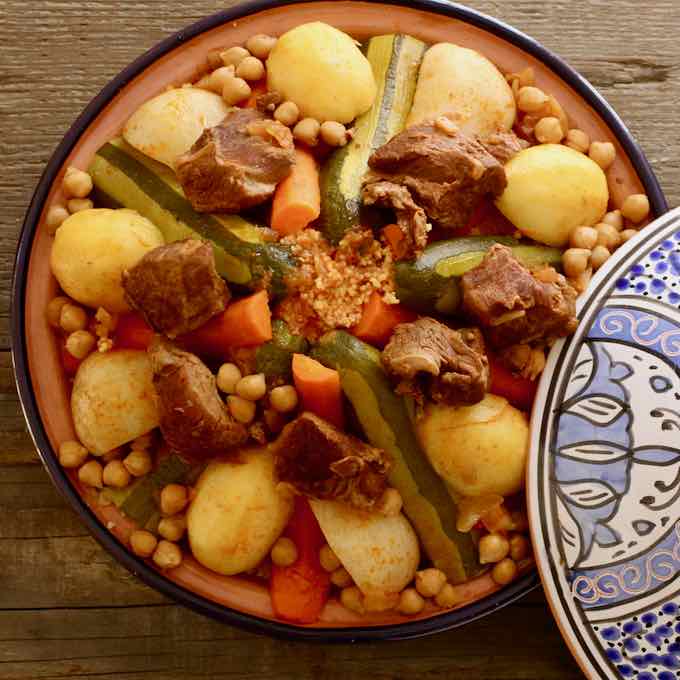Tunisian Couscous: The National Dish of Tunisia
If there’s one dish that defines Tunisia, it’s couscous. But forget the idea of plain, fluffy grains served as a side — in Tunisia, couscous is the centerpiece of the meal. It’s steamed semolina topped with a rich, spiced sauce and paired with lamb, chicken, or fish depending on the region. Always colorful, always fragrant, and often spicy with harissa, Tunisian couscous is more than food — it’s tradition.
We first tasted couscous in Monastir on a Friday afternoon, when the smell of simmering sauce drifted from every home and café. A bowl arrived piled high: golden grains at the bottom, tender lamb and carrots nestled on top, and a drizzle of fiery broth bringing it all together. It wasn’t just a meal, it was a ritual — hearty, generous, and shared with family and friends.
Couscous is Tunisia’s national dish, but it’s also a weekly tradition. Fridays, the holy day in Islam, are often marked with a communal couscous meal. Families gather, neighbors share, and even restaurants prepare special versions.
What makes Tunisian couscous unique is its adaptability. Coastal towns like Sousse and Monastir often prepare it with freshly caught fish, while inland areas lean toward lamb or chicken. In winter, root vegetables and chickpeas make it hearty; in summer, it might be lighter with zucchini and peppers. No two bowls are ever quite the same, but all carry the same spirit of warmth and generosity.

What’s the difference between Tunisian and Moroccan couscous?
Moroccan couscous is often mildly spiced and served with a variety of vegetables and dried fruits like raisins or apricots. Tunisian couscous, on the other hand, has a bolder flavor, thanks to harissa and a more tomato-based sauce. It’s spicier, earthier, and often served with fish along the coast.
Why is couscous the national dish of Tunisia?
Couscous is more than a dish — it’s part of Tunisia’s cultural identity. It’s eaten at weddings, funerals, religious holidays, and every Friday family gathering. Because it adapts to seasons, regions, and what’s available, it represents Tunisia’s diversity while uniting people around one shared table.
What meat is used in Tunisian couscous?
Traditionally, lamb and chicken are the most common, especially in inland Tunisia. On the coast, fish couscous is a local specialty — often made with sea bass, grouper, or sardines.
Is Tunisian couscous spicy?
Yes, typically. The addition of harissa gives it heat and depth. However, the spice level can be adjusted — some households make it mild for children, while others make it fiery.
Is Tunisian couscous healthy?
Couscous is a balanced dish: semolina provides energy, chickpeas and vegetables add fiber and vitamins, and meat or fish brings protein. Because it’s steamed, the grains stay light, and the dish overall is hearty but not heavy.
Can you make Tunisian couscous vegetarian?
Absolutely. Many Tunisian families prepare couscous with only seasonal vegetables and chickpeas. The broth is still flavorful, rich with spices, tomato, and olive oil.
Share this recipe
Tunisian Couscous

NUTRITION
Ingredients
- 2 cups couscous semolina grains
- 3 tbsp olive oil
- 500 g lamb chicken, or fish (such as sea bass or grouper), cut into pieces
- 1 large onion finely chopped
- 2 cloves garlic minced
- 2 tbsp tomato paste
- 1 tbsp harissa adjust to taste
- 1 tsp ground cumin
- 1 tsp ground coriander
- 1 tsp paprika
- ½ tsp turmeric
- 4 cups vegetable or chicken stock
- 2 carrots peeled and chopped
- 2 zucchini chopped
- 1 potato cubed
- 1 handful of chickpeas pre-cooked or canned
- Salt and pepper to taste
- Fresh parsley or cilantro for garnish
- Lemon wedges to serve
Instructions
- Prepare the couscous: Place the couscous in a bowl, drizzle with 2 tbsp olive oil, and fluff with a fork. Add 1 cup boiling water, cover, and let steam for 5 minutes. Fluff again and set aside. (Traditional method: steam couscous in a couscoussier for richer flavor.)
- Cook the sauce: In a large pot, heat 1 tbsp olive oil. Add onion and garlic, sauté until soft. Stir in tomato paste, harissa, and spices, and cook for 2 minutes until fragrant.
- Add the meat or fish: Add lamb or chicken pieces (if using fish, add later to avoid overcooking) and sear lightly in the sauce.
- Simmer: Pour in stock, bring to a boil, then reduce to a simmer. Add carrots, zucchini, potato, and chickpeas. Cook for 30–40 minutes until meat is tender and vegetables are soft.
- If using fish: Add fish pieces in the last 10 minutes of cooking.
- Assemble: Spoon couscous into bowls or a large serving dish. Ladle sauce, meat/fish, and vegetables over the top.
- Finish: Garnish with parsley or cilantro and serve with lemon wedges on the side.
More Tunisian Recipes

